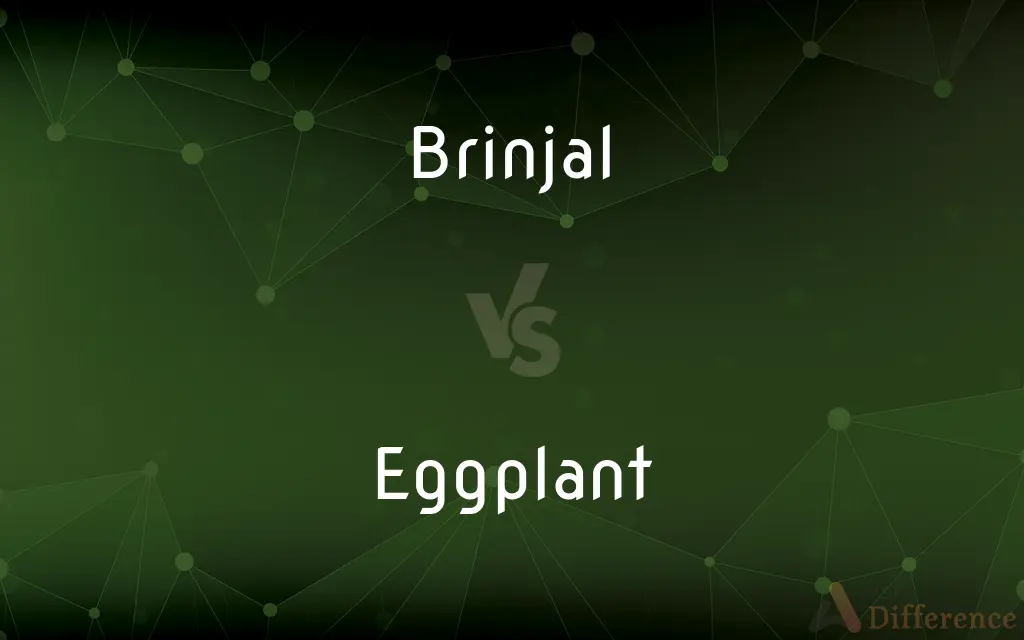Brinjal vs. Eggplant — What's the Difference?
By Tayyaba Rehman — Updated on October 3, 2023
Brinjal and eggplant refer to the same vegetable. "Brinjal" is commonly used in South Asia, while "eggplant" is standard in American English. Both names describe the purple, oblong fruit of the plant.

Difference Between Brinjal and Eggplant
Table of Contents
ADVERTISEMENT
Key Differences
Brinjal and eggplant are terms that describe the same edible fruit of the Solanum melongena plant. The differences between these words primarily lie in regional usage. Brinjal is a term often utilized in countries like India, Pakistan, Bangladesh, and South Africa. Conversely, eggplant is the term preferred in the United States, Canada, and Australia.
Brinjal and eggplant have made their way into many cuisines worldwide. In Indian cuisine, dishes such as "Baingan Bharta" utilize the brinjal as the primary ingredient. In contrast, in American or Italian cuisines, one might find dishes like eggplant parmesan, where the eggplant is breaded and baked with cheese and tomato sauce.
Though brinjal and eggplant sound distinctly different, they both have roots in language history. Brinjal stems from the Portuguese "beringela", which in turn was borrowed from Arabic. Eggplant, however, gets its name from the white or yellowish cultivars that resemble goose or chicken eggs.
Interestingly, both brinjal and eggplant, despite being fruits botanically, are treated and cooked as vegetables in culinary contexts. Whether called brinjal or eggplant, this vegetable has become a staple in many households, symbolizing the cross-cultural importance of this versatile ingredient.
Comparison Chart
Origin of Name
Portuguese
English
ADVERTISEMENT
Common Usage
South Asia
North America
Derived From
"beringela"
Shape & Color
Botanical Classification
Fruit
Fruit
Culinary Use
Treated as vegetable
Treated as vegetable
Compare with Definitions
Brinjal
Brinjal, botanically a fruit, is commonly used as a culinary vegetable.
He roasted the brinjal for a smoky flavor.
Eggplant
Eggplants got their name from their egg-like shape and color in some varieties.
The garden had small, white eggplants resembling eggs.
Brinjal
Brinjal is known for its absorbent flesh, making it suitable for grilling and frying.
He marinated the brinjal slices before grilling.
Eggplant
Eggplant is an oblong, purple fruit consumed as a vegetable in Western cuisines.
She layered the lasagna with thin slices of eggplant.
Brinjal
Brinjal can be found in various colors, though purple is most common.
She picked a white brinjal from the market today.
Eggplant
Eggplant, a member of the nightshade family, is rich in antioxidants.
He learned that eggplant was good for his health.
Brinjal
Brinjal is a glossy, purple vegetable popular in South Asian cuisines.
She added diced brinjal to her curry.
Eggplant
Eggplants are versatile and can be grilled, roasted, or stewed.
She made a creamy eggplant dip for the party.
Brinjal
Brinjal belongs to the nightshade family alongside tomatoes and peppers.
She was surprised to learn tomatoes and brinjals were related.
Eggplant
Eggplants vary in size, color, and shape, depending on the variety.
She chose a long, slender eggplant for her recipe.
Brinjal
An aubergine.
Eggplant
Eggplant (US, Australia, New Zealand, anglophone Canada), aubergine (UK, Ireland, Quebec, and most of mainland Western Europe) or brinjal (South Asia, Singapore, Malaysia, South Africa) is a plant species in the nightshade family Solanaceae. Solanum melongena is grown worldwide for its edible fruit.
Brinjal
An aubergine or eggplant.
Eggplant
The purple egg-shaped fruit of a tropical Old World plant, which is eaten as a vegetable; an aubergine.
Brinjal
Hairy upright herb native to southeastern Asia but widely cultivated for its large glossy edible fruit commonly used as a vegetable
Eggplant
The large plant of the nightshade family which bears aubergines.
Eggplant
A plant (Solanum melongena) native to India, cultivated for its edible, glossy, usually ovoid fruits that are chiefly purple but can be white, yellow, or green.
Eggplant
A fruit of this plant. Also called aubergine.
Eggplant
A blackish purple.
Eggplant
The plant Solanum melongena.
Eggplant
The edible fruit of the Solanum melongena: an aubergine.
Eggplant
(North America) A dark purple color, like that of the skin of this fruit.
Eggplant
A black person (used mainly by Italian-Americans).
Eggplant
A 180 backside rotated invert in which the front hand is planted on the lip of the halfpipe wall
Eggplant
A plant (Solanum Melongena), of East Indian origin, allied to the tomato, and bearing a large, glossy, edible fruit, shaped somewhat like an egg; mad-apple. It is widely cultivated for its fruit, commonly eaten as a vegetable.
Eggplant
The fruit of the eggplant{1}.
Eggplant
Egg-shaped vegetable having a shiny skin typically dark purple but occasionally white or yellow
Eggplant
Hairy upright herb native to southeastern Asia but widely cultivated for its large glossy edible fruit commonly used as a vegetable
Common Curiosities
Is the brinjal a fruit or vegetable?
Botanically, brinjal is a fruit, but it's treated as a vegetable in culinary contexts.
What is the origin of the name "brinjal"?
Brinjal is derived from the Portuguese word "beringela."
What is a brinjal?
Brinjal is a glossy, purple vegetable, commonly used in South Asian cuisines.
Can I substitute brinjal for eggplant in recipes?
Yes, since brinjal and eggplant are the same, they can be used interchangeably.
Is there a difference between brinjal and eggplant?
No, they refer to the same vegetable but are used in different regions.
Where is the term "brinjal" commonly used?
Brinjal is commonly used in South Asia, including countries like India and Bangladesh.
Why is it called "eggplant" in America?
The term "eggplant" is derived from the white or yellowish varieties that resemble goose or chicken eggs.
What are the health benefits of eggplant?
Eggplant is rich in fiber, vitamins, and antioxidants, making it beneficial for heart health and more.
How is eggplant used in Western cuisines?
In Western cuisines, eggplant is often grilled, baked, or used in dishes like eggplant parmesan.
Which regions primarily use the term "eggplant"?
The term "eggplant" is predominantly used in North America, Canada, and Australia.
How do I reduce the bitterness of a brinjal?
Salting sliced or cubed brinjal and letting it sit for about 30 minutes can help reduce bitterness.
Are there different varieties of brinjal?
Yes, brinjals come in various sizes, shapes, and colors, including purple, white, and green.
Do both brinjal and eggplant belong to the nightshade family?
Yes, both brinjal and eggplant belong to the nightshade family, along with tomatoes and peppers.
How should I store eggplants?
Eggplants should be stored in a cool, dry place and are best used within a few days.
Is the skin of the eggplant edible?
Yes, the skin of the eggplant is edible, but some prefer to peel it for certain recipes.
Share Your Discovery

Previous Comparison
Flagstone vs. Bluestone
Next Comparison
Flexible vs. RigidAuthor Spotlight
Written by
Tayyaba RehmanTayyaba Rehman is a distinguished writer, currently serving as a primary contributor to askdifference.com. As a researcher in semantics and etymology, Tayyaba's passion for the complexity of languages and their distinctions has found a perfect home on the platform. Tayyaba delves into the intricacies of language, distinguishing between commonly confused words and phrases, thereby providing clarity for readers worldwide.














































